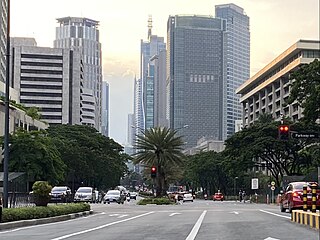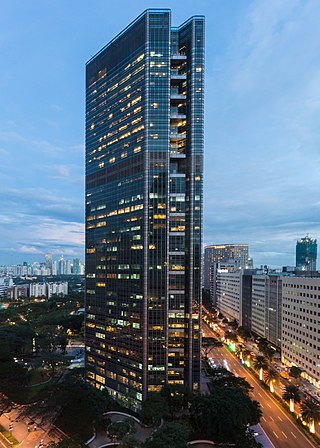
Makati, officially the City of Makati, is a highly urbanized city in the National Capital Region of the Philippines, known for being one of the leading financial centers in the country. As of 2013, the city has the highest concentration of multinational and local corporations in the Philippines. Major banks, corporations, department stores as well as foreign embassies are based in Makati. Makati is also known for being a major cultural and entertainment hub in Metro Manila. According to the 2020 census, it had a population of 629,616 people, making it the 47th most populous city in the country and 8th most populous in Metro Manila. Makati is one of the most densely populated city proper areas globally, ranking 8th worldwide and 2nd in the Philippines, after Manila, with a population density of 28,975 inhabitants per square kilometer.

The Ayala Center is a 50-hectare (120-acre) mixed-use major commercial development operated by Ayala Land located in Barangay San Lorenzo within the Makati Central Business District in Makati, Metro Manila, Philippines. The complex comprises three shopping malls, three department stores, each with its own retail shops, restaurant arcades and cinemas, several hotels, eight residential towers, five office towers, four parking buildings, and leisure amenities such as the Greenbelt Park, Glorietta 3 Park, and the Ayala Museum, showcasing exhibits on Philippine history and art.

Glorietta, also known as Ayala Malls Glorietta, formerly known as Quad, is a shopping mall complex in the Ayala Center, Makati, Metro Manila, Philippines. The mall is owned by Ayala Land and operated through its subsidiary, the Ayala Malls. The mall is divided into five sections and contains many shops and restaurants, as well as cinemas, gyms, arcades and two central activity centers. Visitors have described the mall as maze-like, due to the complexity of its interior layout.

The Ayala Museum is a museum in Makati, Metro Manila, Philippines. It is run privately by the Ayala Foundation and houses archaeological, ethnographic, historical, fine arts, numismatics, and ecclesiastical exhibits. Since its establishment in April 1967, the museum has been committed to showcasing overseas collections and situating contemporary Philippine art in the global arena in a two-way highway of mutual cooperation and exchange with local and international associates. The museum was reopened on December 4, 2021, after a two-year renovation.

Ayala Avenue is a major thoroughfare in Makati, the Philippines. It is one of the busiest roads in Metro Manila, crossing through the heart of the Makati Central Business District. Because of the many businesses along the avenue, Ayala Avenue is nicknamed the "Wall Street of the Philippines" and dubbed in the 1970s and 1980s as the "Madison Avenue of the Philippines".

Leandro Valencia Locsin, Sr., also known by the initials LVL and the nickname "Lindy", was a Filipino architect, artist, and interior designer known for his use of concrete, floating volume and simplistic design in his various projects. An avid collector, he was fond of modern painting and Chinese ceramics. He was proclaimed a National Artist of the Philippines for Architecture in 1990 by the late President Corazon C. Aquino.

Tower One & Exchange Plaza is one of the tallest skyscrapers in the Philippines. It is located in the Makati Central Business District and has a height of 160 meters (520 ft). The building has 35 floors above ground level, and is originally planned to be the first of three towers for the Ayala Triangle. Plans for the construction of the two additional buildings did not materialize until 2021, due to the completion of the Ayala Triangle North complex. The area adjacent to the tower composes of 3 buildings, the Ayala Tower One, The Makati Stock Exchange (MkSE) and the former trading floor of the Philippine Stock Exchange.

Greenbelt, also known as Ayala Malls Greenbelt, is a shopping mall located at Ayala Center, Makati, Metro Manila, Philippines. It is owned by Ayala Malls, a real-estate subsidiary of Ayala Land, which is an affiliate of Ayala Corporation. It opened in 1988 after merging existing structures and is one of the Ayala Corporation's flagship projects. The mall offers a mix of high-end retail shops, restaurants, amenities, leisure and entertainment. Currently, the mall has five sections: two enclosed areas, two buildings with open-air shopping areas, and Greenbelt 5, which was opened in 2007.

Saint Andrew the Apostle Parish Church is a Roman Catholic church in Bel-Air Village, Makati, Philippines. It is one of the known modern edifices designed by Leandro V. Locsin in Makati. Dedicated to Andrew the Apostle, the patron saint of Metro Manila and Bel-Air Village, the church is under the jurisdiction of the Archdiocese of Manila. Its parish territories are Bel-Air Village and Salcedo Village in Barangay Bel-Air, Rizal Village and Santiago Village in Barangay Valenzuela, and San Miguel Village in Barangay Poblacion.

InterContinental Manila was a five-star InterContinental hotel located on Ayala Avenue in Makati, Metro Manila, Philippines. At the time of its closure, it was the longest operating international chain hotel in the Philippines. It was designed by National Artist Leandro Locsin.

Holiday Inn & Suites Makati is a hotel in Makati, Metro Manila, Philippines. It opened on April 1, 2013, as part of the New Glorietta Phase 1 redevelopment. The hotel is built on top of a redeveloped Glorietta shopping mall in Ayala Center. The hotel is managed by InterContinental Hotels Group.

Senator Gil J. Puyat Avenue, also known simply as Gil Puyat Avenue and by its former official name Buendia Avenue, is a major arterial thoroughfare which runs east–west through Makati and Pasay in western Metro Manila, Philippines. It is one of the busiest avenues in Metro Manila, linking the Makati Central Business District with the rest of the metropolis.

Makati Avenue is a major commercial thoroughfare in Makati, Metro Manila, Philippines. It forms the eastern border of the Ayala Triangle and is one of the three main avenues of the Makati Central Business District. The avenue runs roughly north–south diagonally, almost parallel to Epifanio de los Santos Avenue (EDSA). It passes through two distinct neighborhoods of the city: the Makati CBD and the old Makati Población. At its northern end lies the older part of Makati, starting from J.P. Rizal Avenue. It continues through Población to Gil Puyat Avenue, marking the southern edge of the old district. South of Gil Puyat onto the CBD, the avenue becomes more commercial and upscale. The Ayala Center shopping hub and Arnaiz Avenue are at its southern end.

The Makati Central Business District is a privately-owned financial and central business district in the Philippines located in the heart of Makati in Metro Manila. It is politically and administratively known as "Central Cluster" in the West District of Makati. It is different from the Makati civic center known as "Makati Poblacion" which is situated at the northeast portion of the district. It is bounded by EDSA, Amorsolo Street, Ayala Avenue, Gil Puyat Avenue, Osmeña Highway, South Luzon Expressway, Metro Manila Skyway, Zobel Roxas Street, Ocampo Street, Metropolitan Avenue, Nicanor Garcia Street, Kalayaan Avenue, Makati Avenue, Anza Street, Polaris Street, Orion Street, Mercedes Street, Amapola Street and Estrella Street. The whole district occupies barangays of San Antonio, San Lorenzo, Bel-Air, and Urdaneta.

McKinley Exchange Corporate Center is a 5-story commercial building, part of a mixed-use complex developed by Ayala Land Inc. as part of the ₱65 billion redevelopment and rebranding of the city of Makati. It is located along McKinley Road corner EDSA in Barangay Dasmariñas and was slated to become the new transport hub of Makati. It is also one of the newest upcoming PEZA-accredited zones, soon to be at par with other 39 Makati zones such as Zuellig Building, RCBC Plaza, and Makati Stock Exchange.

Circuit Makati is a riverfront redevelopment project by Ayala Land on the site of the former Santa Ana Race Track in Makati, Metro Manila, Philippines. The 21-hectare (52-acre) site located in the northwest portion of Makati, on the south bank of the Pasig River, is planned to contain a mixed-use entertainment complex which would include an indoor theater, a shopping mall, hotels and residential and office skyscrapers. It would also contain a football turf, skate park and an outdoor entertainment area. The development is envisioned to become the new entertainment district of Makati and the city's lifestyle hub.

The Ayala Triangle Gardens is a 2-hectare (4.9-acre) landscaped urban park in Makati, Metro Manila, Philippines. It is a triangular public garden and courtyard in the center of the Makati Central Business District. It was named after its owner and developer Ayala Land, and opened to the public in November 19, 2009. Inspired by Hyde Park in London, the park, which is dotted with palms, acacia trees, and tropical foliage, is considered one of the few "green" areas in Makati.

L. V. Locsin Building is a 19-storey office building at 6752 Ayala Avenue. Named after its designer, National Artist for Architecture Leandro Locsin, and completed in 1985, it is notable for its Brutalist architectural style and the architect's signature of floating volumes. With an estimated height of 74.8 meters (245 ft), the building is the first in the Philippines to have no corner columns, evident in the corners of the building where the main emergency staircase is located, highly visible at night with the lights switched on.

One Ayala, also known as One Ayala Avenue (OAA), is a mixed-use development developed by Ayala Land located at Ayala Center via EDSA (C-4) in Makati, Metro Manila, Philippines. It is located across Glorietta mall and occupies the former InterContinental Manila and EDSA Carpark sites. It aims to combine retail, hotel, and office facilities in a single contiguous space. Construction began in 2016 with the demolition of InterContinental Manila and EDSA Carpark and parts of the development opened in 2022.

Park Central Towers is a complex of two skyscrapers currently under construction in Makati, Metro Manila, Philippines. The first building, the Park Central South Tower is already topped-off.






















